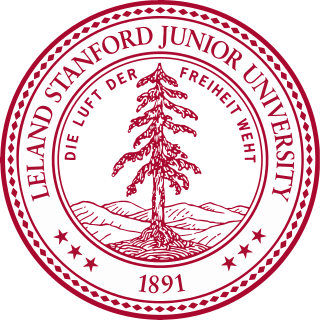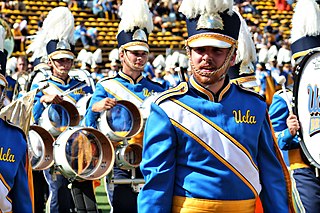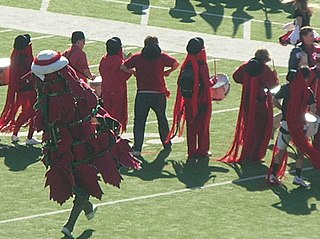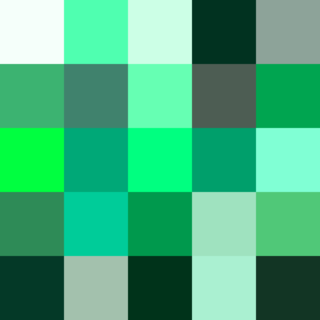
Green is the color between cyan and yellow on the visible spectrum. It is evoked by light which has a dominant wavelength of roughly 495–570 nm. In subtractive color systems, used in painting and color printing, it is created by a combination of yellow and cyan; in the RGB color model, used on television and computer screens, it is one of the additive primary colors, along with red and blue, which are mixed in different combinations to create all other colors. By far the largest contributor to green in nature is chlorophyll, the chemical by which plants photosynthesize and convert sunlight into chemical energy. Many creatures have adapted to their green environments by taking on a green hue themselves as camouflage. Several minerals have a green color, including the emerald, which is colored green by its chromium content.

Stanford University is a private research university in Stanford, California. It was founded in 1885 by railroad magnate Leland Stanford, the eighth governor of and then-incumbent senator from California, and his wife, Jane, in memory of their only child, Leland Jr. The university admitted its first students in 1891, opening as a coeducational and non-denominational institution. It struggled financially after Leland died in 1893 and again after much of the campus was damaged by the 1906 San Francisco earthquake. Following World War II, university provost Frederick Terman inspired an entrepreneurial culture to build a self-sufficient local industry.

Purple is a color similar in appearance to violet light. In the RYB color model historically used in the arts, purple is a secondary color created by combining red and blue pigments. In the CMYK color model used in modern printing, purple is made by combining magenta pigment with either cyan pigment, black pigment, or both. In the RGB color model used in computer and television screens, purple is created by mixing red and blue light in order to create colors that appear similar to violet light.

A logo is a graphic mark, emblem, or symbol used to aid and promote public identification and recognition. It may be of an abstract or figurative design or to include the text of the name that it represents as in a wordmark.

Palo Alto is a charter city in the northwestern corner of Santa Clara County, California, United States, in the San Francisco Bay Area, named after a coastal redwood tree known as El Palo Alto.

Gold, also called golden, is a color tone resembling the gold chemical element.

School colors, also known as university colors or college colors, are the colors chosen by a school, academy, college, university or institute as part of its brand identity, used on building signage, web pages, branded apparel, and the uniforms of sports teams. They can promote connection to the school, known as "school spirit", and help differentiate it from other institutions.

Cardinal is a vivid red, which may get its name from the cassocks worn by Catholic cardinals. The cardinal bird also takes its name from the cardinal bishops.

Scarlet is a bright red color, sometimes with a slightly orange tinge. In the spectrum of visible light, and on the traditional color wheel, it is one-quarter of the way between red and orange, slightly less orange than vermilion.

The Stanford Tree is the Stanford Band's mascot and the unofficial mascot of Stanford University. Stanford's team name is "Cardinal", referring to the vivid Stanford Cardinal Red color, and the university does not have an official mascot. The Tree, in various versions, has been called one of America's most bizarre and controversial college mascots. The tree regularly appears at the top of Internet "worst mascot" lists but has also appeared on at least one list of top mascots.

Spring green is a color that was traditionally considered to be on the yellow side of green, but in modern computer systems based on the RGB color model is halfway between cyan and green on the color wheel.
Visual design elements and principles describe fundamental ideas about the practice of visual design.
Earth tone is a term used to describe a palette of colors that are similar to natural materials and landscapes. These colors are inspired by the earth's natural hues, including browns, greens, grays, and other warm and muted shades. The term earth tone first became popular in the 1970s during the environmental movement, as people sought to reconnect with nature and embrace more natural and organic lifestyles.
Yale Blue is the dark blue color used in association with Yale University.

Varieties of the color green may differ in hue, chroma or lightness, or in two or three of these qualities. Variations in value are also called tints and shades, a tint being a green or other hue mixed with white, a shade being mixed with black. A large selection of these various colors is shown below.

Varieties of the color blue may differ in hue, chroma, or lightness, or in two or three of these qualities. Variations in value are also called tints and shades, a tint being a blue or other hue mixed with white, a shade being mixed with black. A large selection of these colors is shown below.

The academic regalia of Stanford University describes the robes, gowns, and hoods which are prescribed by the university for its graduates. Stanford University was founded in 1891 and academic dress has been a part of academic life at the school since at least 1899. As in most American universities, the academic dress found at Stanford is derived from that of the universities of Oxford and Cambridge, which was a development of academic and clerical dress common throughout the medieval universities of Europe. Today, also in common with most American universities, academic regalia is commonly seen only at graduation ceremonies. For most of its academic dress, Stanford follows the Intercollegiate Code of Academic Costume which was devised in 1895 and sets out a detailed uniform scheme of academic regalia. Stanford does make use of a distinct robe for its PhD graduates which is unique among American institutions of higher education in being based specifically on the doctoral robes of the University of Cambridge.
LYFE Kitchen is an American fast-casual restaurant chain operating in Illinois. The company's name is an acronym that stands for "Love Your Food Everyday". LYFE promises functional, locally sourced foods and does not use artificial ingredients. They strive to use 100% biodegradable, compostable, recyclable packaging.
Sally Fox is a cotton breeder who breeds naturally colored varieties of cotton. She is the inventor of Foxfibre®️ and founder of the company Natural Cotton Colors Inc. Fox invented the first species of environmentally friendly colored cotton that could be spun into thread on a machine.
Stanford Cardinal Red is a deep red color associated with Stanford University. It is the primary color of the university and is used prominently in its branding, athletic uniforms, and official publications alongside the university's secondary color, Palo Alto Green.










